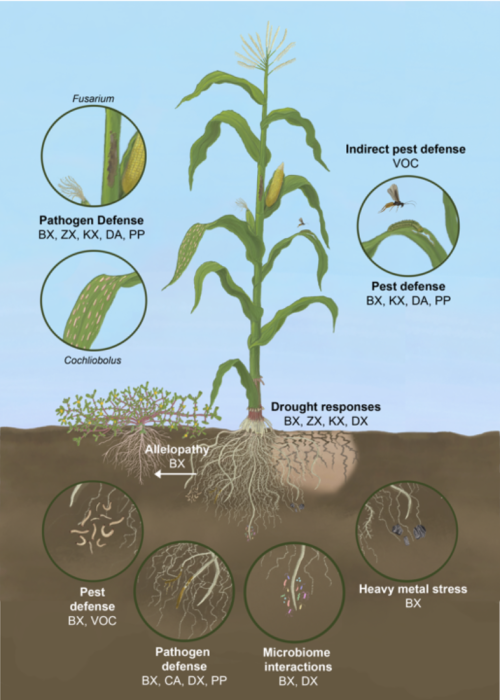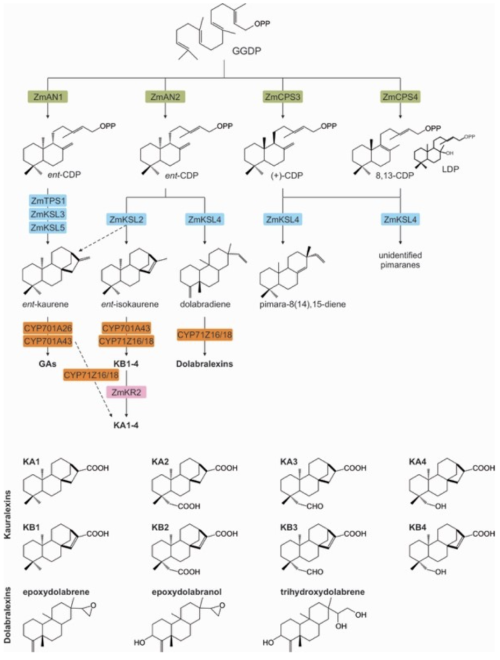
Extremely diverse and largely unresolved plant specialized metabolites defend crop plants against pests, pathogens and other stresses. Additionally, complex combinations of biotic and abiotic stresses hamper defense capacities, causing expanded pathogen susceptibility and yield losses. Essential to the understanding and agricultural optimization of plant resilience is a fundamental knowledge of the metabolic networks that govern innate immunity and vigor.
As the world's largest annually harvested crop, maize (Zea mays) is protected by an array of functionalized terpenoids that are formed specifically to impede pathogen progression at sites of attack. Recent research advances highlight the opportunity and value of precisely examining the genetic, biochemical and functional breadth of maize biochemical defenses. Our research aims to unravel maize terpenoid biosynthesis and stress resistance relationships to address prevalent knowledge gaps.

We elucidated several biosynthetic pathways leading to the production of distinct groups of bioactive terpenoids involved in stress responses to biotic and abiotic environmental perturbations in maize. For example, we demonstrated that at least two groups of bioactive maize diterpenoids exist, which are derived from a common ent-copalyl diphosphate (CPP) precursor produced by the ent-CPP synthase, anther ear 2 (ZmAN2). Two class I diTPSs, kaurene synthase-like 2 (ZmKSL2) and ZmKSL4 catalyze the conversion of ent-CPP into the diterpene scaffolds en route to kauralexins and dolabralexins. In addition to their antifungal activities, our research suggests that root dolabralexins function in the interaction of maize with beneficial soil microbes. We further generated insights into how plants regulate pathways that evolved from the duplication and divergence from ancestral hormone pathways. Without close regulation, defense-related biosynthetic pathways that evolved from core hormone pathways could drive the dysregulation of the original primary processes. We could show ZmKSL2 and ZmKSL4 modularly interact with ZmAN2 to form a dynamic metabolic network generating defensive diterpenoids. The same ent-CPP precursor supplies gibberellin growth hormone production. This occurrence is likely subtle as the pathways we discovered (kauralexins, dolabralexins) conceptually serve as “release valves” which prevent defense precursors from accumulating and acting as substrates for growth hormone production. The impact of our targeted diterpenoid pathway discovery efforts enabled us to elucidate biosynthetic nodes where growth and defense processes are controlled and how knowledge of diterpenoid defenses inform and impact dramatic growth phenotypes in maize.
If you would like to read more:
- Yasmin F, Cowie AE, Zerbe P (2024) Understanding the chemical language mediating maize immunity and environmental adaptation. New Phytol. 243:2093-2101. [Link]
- Köllner TG, Gershenzon J, Peters RJ, Zerbe P, Schmelz EA (2023) The terpene synthase gene family in maize - a clarification of existing community nomenclature. BMC Genomics 24:744. [Link]
- Murphy KM, Dowd T, Khalil A, Char SN, Yang B, Endelman BJ, Shih PM, Topp C, Schmelz EA, Zerbe P (2023) A dolabralexin-deficient mutant provides insight into specialized diterpenoid metabolism in maize. Plant Physiol. 192:1338-1358. [Link]
- Murphy KM, Poretsky E, Liu H, Micic N, Nyhuis A, Bohlmann J, Schmelz EA, Zerbe P, Huffaker A, Bjarnholt N (2022) Shielding the oil reserves: the scutellum as a source of chemical defenses. Plant Physiol. 188:1944-1949. [Link]
- Murphy KM, Edwards J, Louie KB, Bowen BP, Sundaresan V, Northen TR, Zerbe P (2021) Bioactive diterpenoids impact the composition of the root-associated microbiome in maize (Zea mays). Sci Rep. 11:333. [Link]
- Ding Y, Weckwerth PR, Poretsky E, Murphy KM, Sims J, Saldivar E, Christensen SA, Char SN, Yang B, Tong AD, Shen Z, Kremling KA, Buckler ES, Kono T, Nelson DR, Bohlmann J, Bakker MG, Vaughan MM, Khalil AS, Betsiashvili M, Dressano K, Köllner TG, Briggs SP, Zerbe P, Schmelz EA, Huffaker A (2020) Genetic elucidation of interconnected antibiotic pathways mediating maize innate immunity. Nat Plants. 6:1375-1388. [Link]
- Murphy KM, Zerbe P (2020) Specialized diterpenoid metabolism in monocot crops: Biosynthesis and chemical diversity. Phytochemistry 172:112289. [Link]
- Ding Y, Murphy KM, Poretsky E, Mafu S, Yang B, Char SN, Christensen SA, Saldivar E, Wu M, Wang Q, Ji L, Schmitz RJ, Kremling KA, Buckler ES, Shen Z, Briggs SP, Bohlmann J, Sher A, Castro-Falcon G, Hughes CC, Huffaker A, Zerbe P, Schmelz EA (2019) Multiple genes recruited from hormone pathways partition maize diterpenoid defences. Nat Plants 5:1043-1056. [Link]
- Murphy KM, Ma LT, Ding Y, Schmelz EA, Zerbe P (2018) Functional Characterization of Two Class II Diterpene Synthases Indicates Additional Specialized Diterpenoid Pathways in Maize (Zea mays). Front Plant Sci. 9:1542. [Link]
- Mafu S, Ding Y, Murphy KM, Yaacoobi O, Addison JB, Wang Q, Shen Z, Briggs SP, Bohlmann J, Castro-Falcon G, Hughes CC, Betsiashvili M, Huffaker A, Schmelz EA, Zerbe P (2018) Discovery, Biosynthesis and Stress-Related Accumulation of Dolabradiene-Derived Defenses in Maize. Plant Physiol. 176:2677-2690. [Link]
This research has been generously supported by:

